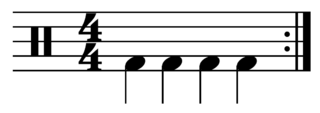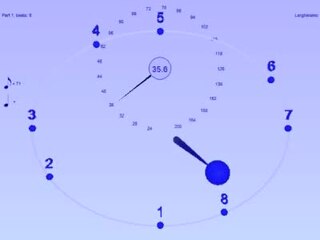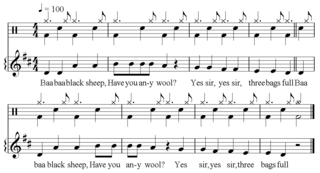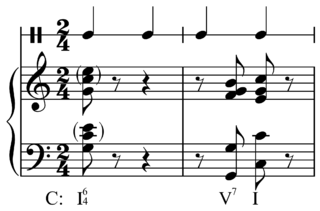 W
WIn music, metre or meter refers to the regularly recurring patterns and accents such as bars and beats. Unlike rhythm, metric onsets are not necessarily sounded, but are nevertheless implied by the performer and expected by the listener.
 W
WAlla breve [alla ˈbrɛːve] – also known as cut time or cut common time – is a musical meter notated by the time signature symbol , which is the equivalent of 22. The term is Italian for "on the breve", originally meaning that the beat was counted on the breve.
 W
WBaladi can refer to an Egyptian musical style, the folk style of Egyptian bellydance, or the Masmoudi Sogheir rhythm, which is frequently used in baladi music. It is also sometimes spelled in English as 'beledi' or 'baladee'.
 W
WIn musical notation, a bar is a segment of time corresponding to a specific number of beats in which each beat is represented by a particular note value and the boundaries of the bar are indicated by vertical bar lines. Dividing music into bars provides regular reference points to pinpoint locations within a musical composition. It also makes written music easier to follow, since each bar of staff symbols can be read and played as a batch.
 W
WIn music and music theory, the beat is the basic unit of time, the pulse, of the mensural level. The beat is often defined as the rhythm listeners would tap their toes to when listening to a piece of music, or the numbers a musician counts while performing, though in practice this may be technically incorrect. In popular use, beat can refer to a variety of related concepts, including pulse, tempo, meter, specific rhythms, and groove.
 W
WThe Bo Diddley beat is a syncopated musical rhythm that is widely used in rock and roll and pop music. The beat is named after rhythm and blues musician Bo Diddley, who introduced and popularized the beat with his self-titled debut single, "Bo Diddley", in 1955. Music educator and author Michael Campbell describes the Bo Diddley beat as:a slightly altered version of the clave rhythm ... [The "Bo Diddley"] song shows the relationship between Afro-Cuban music, Americanized Latin rhythms, and rock rhythm ... [The beats] are more active and complicated than a simple rock rhythm, but less complex than a real Afro-Cuban rhythm.
 W
WCanter time, canter timing or canter rhythm is a two-beat regular rhythmic pattern of a musical instrument or in dance steps within 34 time music. The term is borrowed from the canter horse gait, which sounds three hoof beats followed by a pause, i.e., 3 accents in 44 time.
 W
WColotomy is an Indonesian description of the rhythmic and metric patterns of gamelan music. It refers to the use of specific instruments to mark off nested time intervals, or the process of dividing rhythmic time into such nested cycles. In the gamelan, this is usually done by gongs of various size: the kempyang, ketuk, kempul, kenong, gong suwukan, and gong ageng. The fast-playing instruments, kempyang and ketuk, keep a regular beat. The larger gongs group together these hits into larger groupings, playing once per each grouping. The largest gong, the gong ageng, represents the largest time cycle and generally indicates that that section will be repeated, or the piece will move on to a new section.
 W
WEntrainment in the biomusicological sense refers to the synchronization of organisms to an external perceived rhythm such as human music and dance. Humans are the only species for which all individuals experience entrainment, although there are documented examples of entrained nonhuman individuals.
 W
WA fermata is a symbol of musical notation indicating that the note should be prolonged beyond the normal duration its note value would indicate. Exactly how much longer it is held is up to the discretion of the performer or conductor, but twice as long is common. It is usually printed above but can be occasionally below the note to be extended.
 W
WA musical figure or figuration is the shortest phrase in music; a short succession of notes, often recurring. It may have melodic pitch, harmonic progression, and rhythmic meter. The 1964 Grove's Dictionary defines the figure as "the exact counterpart of the German 'motiv' and the French 'motif'": it produces a "single complete and distinct impression". To the self-taught Roger Scruton, however, a figure is distinguished from a motif in that a figure is background while a motif is foreground:A figure resembles a moulding in architecture: it is 'open at both ends', so as to be endlessly repeatable. In hearing a phrase as a figure, rather than a motif, we are at the same time placing it in the background, even if it is ... strong and melodious
 W
WFour-on-the-floor is a rhythm pattern used primarily in disco and electronic dance music. It is a steady, uniformly accented beat in 4/4 time in which the bass drum is hit on every beat in common time. This was popularized in the disco music of the 1970s and the term four-on-the-floor was widely used in that era: it originated with the pedal-operated, drum-kit bass drum. Earl Young is seen as the inventor of the disco style of rock drumming, as he was the first to make extensive and distinctive use of the hi-hat cymbal throughout the playing time of an R&B recording.
 W
WIn music, groove is the sense of an effect ("feel") of changing pattern in a propulsive rhythm or sense of "swing". In jazz, it can be felt as a quality of persistently repeated rhythmic units, created by the interaction of the music played by a band's rhythm section. Groove is a significant feature of popular music, and can be found in many genres, including salsa, rock, soul, funk, and fusion.
 W
WIn popular music, half-time is a type of meter and tempo that alters the rhythmic feel by essentially doubling the tempo resolution or metric division/level in comparison to common-time. Thus, two measures of 44 approximate a single measure of 88, while a single measure of 4/4 emulates 2/2. Half-time is not to be confused with alla breve or odd time. Though notes usually get the same value relative to the tempo, the way the beats are divided is altered. While much music typically has a backbeat on quarter note (crotchet) beats two and four, half time would increase the interval between backbeats to double, thus making it hit on beats three and seven, or the third beat of each measure :1 2 3 4 1 2 3 4 1 2 3 4 5 6 7 8 1 2 3 4
 W
WIn musical notation, a bar is a segment of time corresponding to a specific number of beats in which each beat is represented by a particular note value and the boundaries of the bar are indicated by vertical bar lines. Dividing music into bars provides regular reference points to pinpoint locations within a musical composition. It also makes written music easier to follow, since each bar of staff symbols can be read and played as a batch.
 W
WIsorhythm is a musical technique using a repeating rhythmic pattern, called a talea, in at least one voice part throughout a composition. Taleae are typically applied to one or more melodic patterns of pitches or colores, which may be of the same or a different length from the talea.
 W
WMaimai is an arcade rhythm game developed and distributed by Sega, in which the player interacts with objects on a touchscreen and executes dance-like movements. The game supports both single-player and multiplayer gameplay with up to 4 players.
 W
WIn music, metric modulation is a change in pulse rate (tempo) and/or pulse grouping (subdivision) which is derived from a note value or grouping heard before the change. Examples of metric modulation may include changes in time signature across an unchanging tempo, but the concept applies more specifically to shifts from one time signature/tempo (metre) to another, wherein a note value from the first is made equivalent to a note value in the second, like a pivot or bridge. The term "modulation" invokes the analogous and more familiar term in analyses of tonal harmony, wherein a pitch or pitch interval serves as a bridge between two keys. In both terms, the pivoting value functions differently before and after the change, but sounds the same, and acts as an audible common element between them. Metric modulation was first described by Richard Franko Goldman while reviewing the Cello Sonata of Elliott Carter, who prefers to call it tempo modulation. Another synonymous term is proportional tempi.A technique in which a rhythmic pattern is superposed on another, heterometrically, and then supersedes it and becomes the basic metre. Usually, such time signatures are mutually prime, e.g., 44 and 38, and so have no common divisors. Thus the change of the basic metre decisively alters the numerical content of the beat, but the minimal denominator remains constant in duration.
 W
WA metronome, from ancient Greek μέτρον and νέμω, is a device that produces an audible click or other sound at a regular interval that can be set by the user, typically in beats per minute (BPM). Metronomes may include synchronized visual motion. Musicians use the device to practise playing to a regular pulse.
 W
WIn music, a motif (pronunciation) (help·info) IPA: (/moʊˈtiːf/) is a short musical phrase, a salient recurring figure, musical fragment or succession of notes that has some special importance in or is characteristic of a composition: "The motive is the smallest structural unit possessing thematic identity".
 W
WMusical phrasing is the way a musician shapes a sequence of notes in a passage of music to allow expression, much like when speaking English a phrase may be written identically but may be spoken differently, and is named for the interpretation of small units of time known as phrases. A musician accomplishes this by interpreting the music—from memory or sheet music—by altering tone, tempo, dynamics, articulation, inflection, and other characteristics. Phrasing can emphasise a concept in the music or a message in the lyrics, or it can digress from the composer's intention, aspects of which are commonly indicated in musical notation called phrase marks or phrase markings. For example, accelerating the tempo or prolonging a note may add tension.A phrase is a substantial musical thought, which ends with a musical punctuation called a cadence. Phrases are created in music through an interaction of melody, harmony, and rhythm.
 W
WIn music, notes inégales refers to a performance practice, mainly from the Baroque and Classical music eras, in which some notes with equal written time values are performed with unequal durations, usually as alternating long and short. The practice was especially prevalent in France in the 17th and 18th centuries, with appearances in other European countries at the same time; and it reappeared as the standard performance practice in the 20th century in jazz.
 W
WIn music theory, a phrase is a unit of musical meter that has a complete musical sense of its own, built from figures, motifs, and cells, and combining to form melodies, periods and larger sections.A phrase is a substantial musical thought, which ends with a musical punctuation called a cadence. Phrases are created in music through an interaction of melody, harmony, and rhythm.
 W
WPolyrhythm is the simultaneous use of two or more rhythms that are not readily perceived as deriving from one another, or as simple manifestations of the same meter. The rhythmic layers may be the basis of an entire piece of music (cross-rhythm), or a momentary section. Polyrhythms can be distinguished from irrational rhythms, which can occur within the context of a single part; polyrhythms require at least two rhythms to be played concurrently, one of which is typically an irrational rhythm. Concurrently in this context means within the same rhythmic cycle. The underlying pulse, whether explicit or implicit can be considered one of the concurrent rhythms. For example, the son clave is poly-rhythmic because its 3 section suggests a different meter from the pulse of the entire pattern.
 W
WIn music, prosody is the way the composer sets the text of a vocal composition in the assignment of syllables to notes in the melody to which the text is sung, or to set the music with regard to the ambiance of the lyrics.
 W
WIn music performances, rhythm guitar is a technique and role that performs a combination of two functions: to provide all or part of the rhythmic pulse in conjunction with other instruments from the rhythm section ; and to provide all or part of the harmony, i.e. the chords from a song's chord progression, where a chord is a group of notes played together. Therefore, the basic technique of rhythm guitar is to hold down a series of chords with the fretting hand while strumming or fingerpicking rhythmically with the other hand. More developed rhythm techniques include arpeggios, damping, riffs, chord solos, and complex strums.
 W
WThe Rhythmicon—also known as the Polyrhythmophone—was an electro-mechanical musical instrument designed and built by Leon Theremin for composer Henry Cowell, intended to reveal connections between rhythms, pitches and the harmonic series. It used a series of perforated spinning disks, similar to a Nipkow disk, to interrupt the flow of light between bulbs and phototoreceptors aligned with the disk perforations. The interrupted signals created oscillations which were perceived as rhythms or tones depending on the speed of the disks. Although it generated both pitches and rhythms, it has often been described as the world's first drum machine.
 W
W"Shave and a Haircut" and the associated response "two bits" is a 7-note musical call-and-response couplet, riff or fanfare popularly used at the end of a musical performance, usually for comedic effect. It is used melodically or rhythmically, for example as a door knock.
 W
WSiteswap, also called quantum juggling or the Cambridge notation, is a numeric juggling notation used to describe or represent juggling patterns. The term may also be used to describe siteswap patterns, possible patterns transcribed using siteswap. Throws are represented by positive integers that specify the number of beats in the future when the object is thrown again: "The idea behind siteswap is to keep track of the order that balls are thrown and caught, and only that." It is an invaluable tool in determining which combinations of throws yield valid juggling patterns for a given number of objects, and has led to previously unknown patterns. However, it does not describe body movements such as behind-the-back and under-the-leg. Siteswap assumes that "throws happen on beats that are equally spaced in time."
 W
WThe Spanish tinge is an Afro-Latin rhythmic touch that spices up the more conventional 44 rhythms commonly used in jazz and pop music. The phrase is a quotation from Jelly Roll Morton. In his Library of Congress recordings, after referencing the influence of his own French Creole culture in his music, he noted the Spanish presence:Then we had Spanish people there. I heard a lot of Spanish tunes. I tried to play them in correct tempo, but I personally didn't believe they were perfected in the tempos. Now take the habanera "La Paloma", which I transformed in New Orleans style. You leave the left hand just the same. The difference comes in the right hand – in the syncopation, which gives it an entirely different color that really changes the color from red to blue. Now in one of my earliest tunes, "New Orleans Blues", you can notice the Spanish tinge. In fact, if you can't manage to put tinges of Spanish in your tunes, you will never be able to get the right seasoning, I call it, for jazz.
 W
WIn tap dancing, jazz, and blues, stop-time is an accompaniment pattern interrupting, or stopping, the normal time and featuring regular accented attacks on the first beat of each or every other measure, alternating with silence or instrumental solos. Stop-time occasionally appears in ragtime music. The characteristics of stop-time are heavy accents, frequent rests, and a stereotyped cadential pattern. Stop-timing may create the impression that the tempo has changed, though it has not, as the soloist continues without accompaniment. Stop-time is common in African-American popular music including R&B, soul music, and led to the development of the break in hip hop.
 W
W W
W W
W W
W